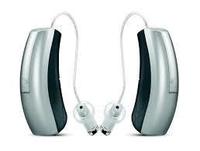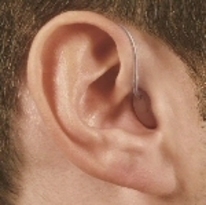- 072-2355343, 054-2105898
- Ha-Tikva St 16-68, 17th Floor, Beer Sheva
- machon.eco@gmail.com
RIC / Receiver-in-the-canal (also RITE)

Receiver-In-Canal (RIC), also known as Receiver-In-The-Ear (RITE), hearing instruments are currently one of the fastest growing segments of the industry. The discreet size and cosmetic appeal of RICs have made them extremely popular. Many patients, however, are borderline candidates based on their hearing loss. Additionally, stock tips may not offer optimal retention.
A Powerful Solution
A new style RIC/RITE hearing device was introduced to the market in 2003 and is having a significant impact on the way hearing aids are fit worldwide. These instruments combine the technology benefits and increased versatility of the traditional BTE with the cosmetic and acoustic advantages of the CIC.
The RIC/RITE style features a receiver that is placed in the ear canal rather than in the BTE case. The receiver is then connected to the sound processor, which is worn behind the ear, via a wire link. Creating a BTE with the receiver in the ear had been attempted by manufacturers in the past but never in a commercially acceptable form until 2003 when one modular design became the basis for all RIC/RITE instruments sold today. This modular design provides audiologists with a very efficient way to deliver both high performance and cosmetics to their patients. The success of the modular RIC/RITE instrument has been apparent through its rapid adoption and acceptance by manufacturers, audiologists and patients, which has led to it becoming the fastest growing style sold today.
RIC technology has become popular for several reasons
* Very discreet fitting
* Modular design allows for multiple acoustic copling options
* Less post fitting side effects
* Occlusion effect reduction
* Reduced acoustic feedback
* More comfortable than traditional instrument
* Quick and efficient single session fit
* Easy to serviceAccommodates high-fidelity, wide bandwidth applications
* Fits mild to profound hearing loss
Modular design
The modular RIC/RITE design allows the audiologist to select the acoustic coupling that best suits a patient's hearing. RIC/RITEs most often are fitted using one of the following three acoustic coupling schemes: Open fit (pre-molded dome/tip or custom earmold); Variable venting (pre-molded dome/tip or custom earmold); or Sealed fit (pre-molded dome/tip or custom earmold). Additionally, multiple receiver units are available during the fitting process that can accommodate the appropriate power and acoustic needs for each patient, and multiple sizes of wire connectors can be chosen to optimize the comfort, performance and appearance of the instrument. Even though a RIC/RITE instrument often is best fit without using a traditional custom earmold, its modularity allows this option to be used on patients when the audiologist determines it to be beneficial.
Occlusion effect reduction - Perhaps the most common side effect of wearing a traditional earmold is the occlusion effect. There are two ways to reduce or eliminate the occlusion effect: Venting and/or open fitting; and Sealed fit in the bony region of the canal. Both methods are possible with a modular RIC/RITE instrument.
The open fitting can provide a very comfortable and easy fit for patients with high-frequency loss, but its benefits are limited when low-frequency amplification is needed. It allows non-amplified sound to pass directly to the eardrum naturally while also allowing low-frequency sounds to escape from the canal, thus reducing and/or eliminating the occlusion effect, but also reducing low-frequency amplification.
Sealing the ear canal in the bony region also keeps the low-frequency sounds of the user's voice from passing to the tympanic membrane, therefore reducing and/or eliminating the occlusion effect, but additionally is able to retain low-frequency amplification as needed. Therefore, the RIC/RITE style fitting can reduce occlusion effects for all levels of hearing loss and amplification.
Reduced feedback sensitivity - Recent advancements in electronic feedback cancellation have been a significant help to audiologists when managing feedback. However, the feedback canceller is not always sufficient, particularly with an open/vented fitting. Managing a feedback issue for an open fitting requires the audiologist to perform one of the following modifications: (1) reduce high-frequency amplification, resulting in reduced user benefit, or (2) reduce venting, which increases occlusion effect. Neither result is desired.
The RIC/RITE instrument offers a distinct advantage for feedback management due to the physical separation of the microphone and receiver. Mechanical feedback occurs when vibrations from the receiver pass through other components or the hearing aid case and enter the microphone. Acoustic feedback results from sound waves coming out of the receiver and reentering the microphone. Consequently, for instruments that fit all in the ear, or in the canal, the feedback path is relatively short. The RIC/RITE design provides a greater separation of transducers over any other ear-level-worn hearing device, thus reducing both mechanical and acoustic feedback sensitivity.

Clinic Echo sells hearing aids at southern Israel - from Ashdod to Arad. For the people that make it difficult to come to our clinic, we offer all services on-site - working or living.
We are on fasebook
Contact Us
- 072-2355343, 054-2105898
- Ha-Tikva St 16-68, 17th Floor, Beer Sheva
- machon.eco@gmail.com


